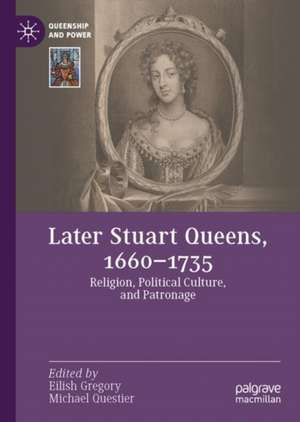Later Stuart Queens, 1660–1735: Religion, Political Culture, and Patronage: Queenship and Power
Editat de Eilish Gregory, Michael C. Questieren Limba Engleză Hardback – 5 ian 2024
Din seria Queenship and Power
- 9%
 Preț: 763.02 lei
Preț: 763.02 lei -
 Preț: 331.87 lei
Preț: 331.87 lei - 20%
 Preț: 752.33 lei
Preț: 752.33 lei -
 Preț: 222.45 lei
Preț: 222.45 lei - 20%
 Preț: 752.33 lei
Preț: 752.33 lei - 20%
 Preț: 691.81 lei
Preț: 691.81 lei - 20%
 Preț: 753.68 lei
Preț: 753.68 lei - 17%
 Preț: 523.55 lei
Preț: 523.55 lei - 20%
 Preț: 693.64 lei
Preț: 693.64 lei - 15%
 Preț: 636.92 lei
Preț: 636.92 lei - 15%
 Preț: 639.90 lei
Preț: 639.90 lei - 15%
 Preț: 582.45 lei
Preț: 582.45 lei -
 Preț: 382.95 lei
Preț: 382.95 lei -
 Preț: 383.93 lei
Preț: 383.93 lei - 18%
 Preț: 727.97 lei
Preț: 727.97 lei -
 Preț: 382.95 lei
Preț: 382.95 lei - 18%
 Preț: 945.92 lei
Preț: 945.92 lei -
 Preț: 387.75 lei
Preț: 387.75 lei - 18%
 Preț: 781.94 lei
Preț: 781.94 lei - 18%
 Preț: 724.63 lei
Preț: 724.63 lei -
 Preț: 388.52 lei
Preț: 388.52 lei -
 Preț: 386.39 lei
Preț: 386.39 lei - 18%
 Preț: 200.00 lei
Preț: 200.00 lei - 18%
 Preț: 728.11 lei
Preț: 728.11 lei -
 Preț: 388.72 lei
Preț: 388.72 lei - 15%
 Preț: 526.35 lei
Preț: 526.35 lei - 15%
 Preț: 692.56 lei
Preț: 692.56 lei - 15%
 Preț: 585.40 lei
Preț: 585.40 lei -
 Preț: 388.72 lei
Preț: 388.72 lei -
 Preț: 383.71 lei
Preț: 383.71 lei -
 Preț: 387.75 lei
Preț: 387.75 lei - 18%
 Preț: 783.98 lei
Preț: 783.98 lei - 15%
 Preț: 640.06 lei
Preț: 640.06 lei - 15%
 Preț: 647.92 lei
Preț: 647.92 lei -
 Preț: 387.75 lei
Preț: 387.75 lei -
 Preț: 388.72 lei
Preț: 388.72 lei - 18%
 Preț: 896.84 lei
Preț: 896.84 lei - 18%
 Preț: 778.45 lei
Preț: 778.45 lei - 19%
 Preț: 178.22 lei
Preț: 178.22 lei -
 Preț: 385.84 lei
Preț: 385.84 lei -
 Preț: 391.61 lei
Preț: 391.61 lei
Preț: 692.18 lei
Preț vechi: 865.23 lei
-20% Nou
Puncte Express: 1038
Preț estimativ în valută:
132.46€ • 143.84$ • 111.27£
132.46€ • 143.84$ • 111.27£
Carte disponibilă
Livrare economică 01-15 aprilie
Livrare express 18-22 martie pentru 35.69 lei
Preluare comenzi: 021 569.72.76
Specificații
ISBN-13: 9783031388125
ISBN-10: 3031388127
Pagini: 368
Ilustrații: XIX, 368 p. 31 illus., 26 illus. in color.
Dimensiuni: 148 x 210 x 30 mm
Greutate: 0.61 kg
Ediția:1st ed. 2023
Editura: Springer International Publishing
Colecția Palgrave Macmillan
Seria Queenship and Power
Locul publicării:Cham, Switzerland
ISBN-10: 3031388127
Pagini: 368
Ilustrații: XIX, 368 p. 31 illus., 26 illus. in color.
Dimensiuni: 148 x 210 x 30 mm
Greutate: 0.61 kg
Ediția:1st ed. 2023
Editura: Springer International Publishing
Colecția Palgrave Macmillan
Seria Queenship and Power
Locul publicării:Cham, Switzerland
Cuprins
Chapter 1: Introduction.- Chapter 2: The Reputation of Dowager Queen Henrietta Maria and the Restoration Monarchy.- Chapter 3: Catherine of Braganza, Queen Dowager of England, 1685-1692: Catholicism and Political Agency.- Chapter 4: Catherine of Bragança, dowager queen of England’s Anglophile Counsel in Portugal, 1693-1705.- Chapter 5: Mary of Modena: Patronage, Poetry, and Power.- Chapter 6: Contesting Catholic Motherhood: Mary Beatrice of Modena, ‘The Glorious Revolution,’ and Queenly Agency.- Chapter 7: Mary II, Poetry and the Construction of Queenship, 1677-1695.- Chapter 8: A World of Interiors: Mary II’s Patronage of the Decorative Arts.- Chapter 9: The Architectural Works Commissioned at Hampton Court by Queen Mary II and Queen Anne.- Chapter 10: ‘Sickly and Spent’: Reassessing the Life and Afterlife of Anne of Great Britain, 1702-1714.- Chapter 11: “The crown can never have too many liveings:” Queen Anne’s patronage of the clergy, 1702–1714.- Chapter 12: ‘La Terrible Catastrofe’: political reactions to the estrangement of Maria Clementina Sobieska and James III, 1725-27.- Chapter 13: ‘‘A Crown of Everlasting Glory”: the Afterlife of Maria Clementina Sobieska in Material and Visual Culture.
Notă biografică
Eilish Gregory is Little Company of Mary Postdoctoral Fellow at the Centre for Catholic Studies in the Department of Theology and Religion at the University of Durham.
Michael C. Questier is Honorary Chair at the Centre for Catholic Studies, University of Durham, UK.
Textul de pe ultima copertă
This book gathers contributions on the later Stuart queens and queen consorts. It seeks to re-insert Henrietta Maria, Catherine of Braganza, Mary of Modena, Mary II, Anne, and Maria Clementina Sobieska into the mainstream of Stuart and early Georgian studies, concentrating on the later Stuart queens from the restoration of King Charles II (who married Catherine of Braganza in 1662) until the death of Maria Clementina Sobieska in 1735, who was married to James Francis Edward Stuart, the titular King James III, otherwise known as the Old Pretender. It showcases these women’s roles as queen consorts and as ruling queens in Britain and Europe, and reveals how their positions allowed them to act as power-brokers, diplomats, patrons, and religious trendsetters during their lifetimes. It also explores their impact in early modern Britain and Europe by assessing their influence in religion, political culture, and the promotion of patronage.
Eilish Gregory isLittle Company of Mary Postdoctoral Fellow at the Centre for Catholic Studies in the Department of Theology and Religion at the University of Durham.
Michael C. Questier is Honorary Chair at the Centre for Catholic Studies, University of Durham, UK.
Caracteristici
Seeks to re-insert queens into the mainstream of Stuart and early Georgian studies Explores queens' participation in political, religious, and cultural exchanges in Britain and Europe Illustrates how queens continued to exercise power as dowagers
